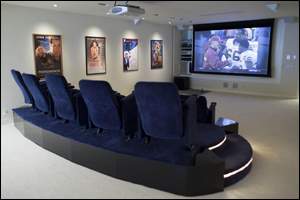Geoffrey Morrison over at Home Theater Magazine has written a great article about home theater lies and It can stand by itself. I would like to add a few comments on how I feel about the article and each of the comments that he makes.
No matter what type of display you’re looking for, you’re no doubt going to be comparing the specs and feature lists of each. Things like contrast ratio, lumens, 3:2 pull down, and others are a marketing departments favorite tools to make their product sound better than another. Take many of these with a grain of salt. Take others as an undersold but vital aspect of a product. To sort though them, here’s what they all mean.
Contrast ratio
I agree with him here that Contrast ratio is a spec that we do not have to worry about. When you are in a stereo store you can compare high and low contrast ratios and I am sur that your HDTV will have more important quality issues than what the contrast ratio is.
Lumens
The number of lumens is the measurement of the brightness of the projector overall. In general you will want a projector with a higher number of lumens as you will want a brighter picture. The only way to compare lumens is to look at the projectors of one company and if you are looking at a projector from another company make sure you know what the relation is between the two comapnies as far as the lumen level is concerned.
Anything called “Edge Enhancement”
Edge enhancement is a sharpness level that apparently will make edges of things on the screen sharper and not so soft. There is usually a very bad payour in that the picture dow not look nearly as smooth and you have jagged lines all over so I believe, as most other pros I think that this is a very bad feature to enable on your TV.
Anything to do with speakers
Speakers come from companies that always lie. Not that speaker companies are bad, but if your competitor is measuring a crazy amount of wattage for speakers then you really need to do the same. My home reciever puts out 70 watts per chann el which is fine but how many car stereos have a wattage of 500-1000 watts per speaker? The numbers tend to be a bit more fair in the home theater industry but I still find that the best way to compare speakers is to go out and compare the same DVD or CD with different speakers connected to the same amplifier, this is by far the very best way to compare home theater speakers.
Comb Filter
A comb filter is the way that a TV will interpret the sgnal coming through composite cables. More than likely you are using Component video (best) or s-video (second best) to connect your DVD player to your TV which mean that the fancy comb filter, good or bad just is not being used.
1080p vs 720p
Geoffrey says do not worry about 1080p as you can not see the difference between that and 720p and he is probably right today. In five years time we will probably care more about 1080p but right now even the video games are really only being created for 720p because it just takes too much to program for 1080p. Look at what you want and what your budget is and remember the quality that you get for 720p is the most important standard to worry about.
 The next time you shop for a new television, odds are good you’ll buy a home-theater system as well.
The next time you shop for a new television, odds are good you’ll buy a home-theater system as well. Did you know that a good quality home theater system can now be had for well under a thousand dollars? If we already have a large enough television, it will cost even less!You may have to make your popcorn in the microwave, get your cold drink out of the fridge and settle for your favorite recliner chair instead of an uncomfortable cinema seat. You won’t have to put up with the chatting or cell phones of you fellow theater goers, but you can have all the fun and excitement of the home theater experience even if you are not yet one of the income earners.
Did you know that a good quality home theater system can now be had for well under a thousand dollars? If we already have a large enough television, it will cost even less!You may have to make your popcorn in the microwave, get your cold drink out of the fridge and settle for your favorite recliner chair instead of an uncomfortable cinema seat. You won’t have to put up with the chatting or cell phones of you fellow theater goers, but you can have all the fun and excitement of the home theater experience even if you are not yet one of the income earners.